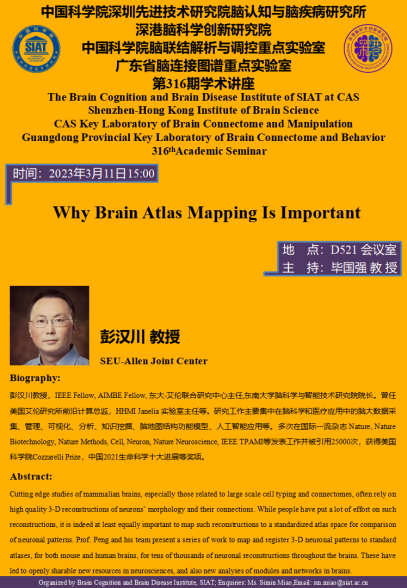Living Fabrications by Engineered Bacteria
时间: 2023-03-09 14:00:00
地点: F13会议室
主持: 王立平 研究员
合成生物学通过构建基因线路等一系列手段与工具编辑特定生物行为,实现绿色制造、生物传感等一系列功能。然而,单细胞难以独自完成复杂、多维度及多层次的任务。通过构建菌群并进行精准调控可极大的拓展单菌理论与应用的范围和深度。本报告将介绍报告人近期实验室工作: 通过编辑单细菌乃至菌群实现多层次、多样式的生物智造。
用计算生物学解析炎症性疾病中T细胞的功能
时间: 2023-03-07 10:00:00
地点: D603 会议室
主持: 鲍进 研究员
T细胞在适应性免疫应答和炎症性疾病发生中发挥着关键作用。近年新兴的单细胞测序及生物信息计算分析有利于深入了解复杂细胞的类型和功能。主讲人博士研究期间利用单细胞RNA测序与T细胞受体测序技术探索了T细胞亚型的特征并解释其在不同器官和疾病中的功能。通过计算分析结合实验验证,该研究重点探索了组织驻留性记忆T细胞在自身免疫肾炎、慢性肝炎和新冠肺炎中的致病作用。该研究结果揭示了细菌/病毒感染和自身免疫等炎症反应之间的密切关联 为炎症性疾病的治疗干预提供了新的途径。
NMDA Receptor Diversity: From Atomic Structure to Brain Function
时间: 2023-02-16 15:30:00
地点: D603 会议室
主持: 陶长路 副研究员
N-methyl-D-aspartate (NMDA) receptors are glutamate-gated and calcium-permeable ion channels that play critical roles in neuronal development, synaptic plasticity, learning and memory. Dysfunction of NMDA receptors has been implicated in depression, epilepsy, chronic pain, Alzheimer’s disease and autoimmune encephalitis...
Allen Mouse Brain Common Coordinate Framework: A 3D Atlas
时间: 2023-02-16 15:30:00
地点: 腾讯会议
主持: 毕国强 教授
In his talk, Dr. Wang will present the Allen Mouse Brain Common Coordinate Framework (CCFv3) as such a resource.
Visualize Molecular Organization in Cells
时间: 2023-02-07 10:00:00
地点: D603会议室
主持: 周鹏程 助理教授
The cytoplasm of a cell is crowded with different kinds of macromolecules. A cell can have more than 1 million protein molecules and hundreds of RNA molecules per μm3. Optical imaging offers very high molecular sensitivity and specificity but can be limited in its multi-color imaging capability and by optical crowding when studying complex molecular organization...
A Synaptic Story of Working Memory
时间: 2023-02-06 14:00:00
地点: D603会议室
主持: 周鹏程 助理教授
In this talk, she will introduce two studies aligning with this STP-based theory.
Neural Circuit Mechanisms of Social Dysfunctions
时间: 2023-01-11 09:00:00
地点: 仅线上
主持: 韩明虎 教授
在人类社会中,社会压力尤其是创伤性社会经历会导致抑郁症、社交焦虑及创伤后应激障碍等多种精神疾病。在抑郁症研究领域,有研究表明社会创伤会损害大脑负责奖赏的脑区功能,使社交活动变得不再有奖赏性,从而导致严重的社交回避行为。尽管对社会创伤及其对社会行为产生的影响已有较多的临床证据,但我们对社交回避所涉及的神经环路知之甚少。科学家利用啮齿类动物抑郁症模型,如慢性社交创伤模型 (chronic social defeat stress, CSDS),在分子,细胞,环路及动物行为等水平上更好地研究和理解控制情绪行为的神经环路机制。CSDS 模型中的抑郁症表型小鼠表现为探索行为降低和对蔗糖等自然奖励的缺失(快感缺失),并伴有严重的社交回避行为。然而该抑郁症模型中的社交回避是否来源于社交奖赏受损是该领域一直悬而未解的问题之一。在本研究中,我们证明了CSDS 抑郁症模型中的社交回避来源于社交奖赏功能受损,并在环路水平上揭示了社交压力阻断社交奖赏的神经机制。
环境污染与脑健康方面的一些探索和思考
时间: 2023-01-10 10:00:00
地点: 仅线上
主持: 屠洁 研究员
环境污染与人体健康密切相关,特别是空气污染,目前研究表明大气细颗粒物和臭氧污染与神经退行性疾病等存在潜在的关联,但其科学证据仍不充分,影响机制也仍有待阐明。我们在大气污染与脑健康方面进行了一些初步的探索,并结合稳定同位素分析、质谱成像等手段,尝试在大气污染与脑健康方面获得一些新的认识。
Large-Scale 3D-EM Connectomics for Studying Neural Circuits
时间: 2023-01-06 13:00:00
地点: 仅线上
主持: 毕国强 教授
3D-EM connectomics is the most suitable approach for studying neural circuit wiring diagrams at synaptic resolution, which is at the core of understanding behavior and cognition. As a result of the still fast-developing imaging and computational reconstruction techniques, connectomics has moved from the limits of only small-scale circuits (e.g., ~100 µm scale retinal circuits) to the one-order larger mouse cortical column (~1 mm)...

 1.png)
 1.png)






